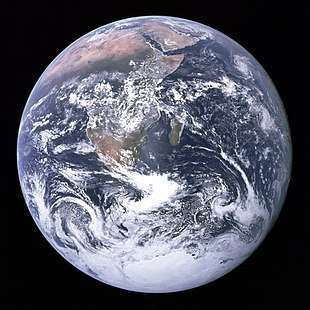Energy conservation
Energy conservation is the effort made to reduce the consumption of energy by using less of an energy service. This can be achieved either by using energy more efficiently (using less energy for a constant service) or by reducing the amount of service used (for example, by driving less). Energy conservation is a part of the concept of Eco-sufficiency. Energy conservation measures (ECMs) in buildings reduce the need for energy services and can result in increased environmental quality, national security, personal financial security and higher savings.[1] It is at the top of the sustainable energy hierarchy.[2] It also lowers energy costs by preventing future resource depletion.[3]
Energy can be conserved by reducing wastage and losses, improving efficiency through technological upgrades and improved operation and maintenance. On a global level energy use can also be reduced by the stabilization of population growth.
Energy can only be transformed from one form to other, such as heat energy to motive power in cars, or kinetic energy of water flow to electricity in hydroelectric power plants. However machines are required to transform energy from one form to other. The wear and friction of the components of these machine while running cause losses of very high amounts of energy and very high related costs. It is possible to minimize these losses by adopting green engineering practices to improve life cycle of the components.[4]
Energy conservation day is celebrated on December 14 every year since 1991.
| Part of a series about |
| Sustainable energy |
|---|
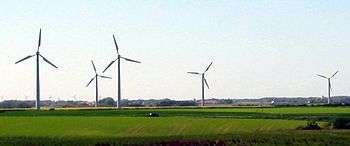 |
| Overview |
| Energy conservation |
| Renewable energy |
| Sustainable transport |
|
Energy tax
Some countries employ energy or carbon taxes to motivate energy users to reduce their consumption. Carbon taxes can motivate consumption to shift to energy sources with less emissions of carbon dioxide, such as solar power, wind power, hydroelectricity or nuclear power while avoiding cars with combustion engines, jet fuel, oil, fossil gas and coal. On the other hand, taxes on all energy consumption can reduce energy use across the board while reducing a broader array of environmental consequences arising from energy production. The state of California employs a tiered energy tax whereby every consumer receives a baseline energy allowance that carries a low tax. As usage increases above that baseline, the tax increases drastically. Such programs aim to protect poorer households while creating a larger tax burden for high energy consumers.[5]
Building design

One of the primary ways to improve energy conservation in buildings is to perform an energy audit. An energy audit is an inspection and analysis of energy use and flows for energy conservation in a building, process or system with an eye toward reducing energy input without negatively affecting output. This is normally accomplished by trained professionals and can be part of some of the national programs discussed above. Recent development of smartphone apps enables homeowners to complete relatively sophisticated energy audits themselves.[7]
Building technologies and smart meters can allow energy users, both commercial and residential, to visualize the impact their energy use can have in their workplace or homes. Advanced real-time energy metering can help people save energy by their actions.[8]
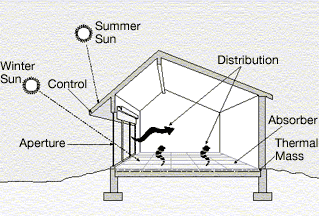
In passive solar building design, windows, walls, and floors are made to collect, store, and distribute solar energy in the form of heat in the winter and reject solar heat in the summer. This is called passive solar design or climatic design because, unlike active solar heating systems, it does not involve the use of mechanical and electrical devices.
The key to designing a passive solar building is to best take advantage of the local climate. Elements to be considered include window placement and glazing type, thermal insulation, thermal mass, and shading. Passive solar design techniques can be applied most easily to new buildings, but existing buildings can be retrofitted.
Businesses implementing ECMs in their commercial buildings often employ Energy Service Companies (ESCOs) experienced in energy performance contracting . This industry has been around since the 1970s and is more prevalent than ever today. The US-based organization EVO (Efficiency Valuation Organization)[9] has created a set of guidelines for ESCOs to adhere to in evaluating the savings achieved by ECMs. These guidelines are called the International Performance Measurement and Verification Protocol (IPMVP).
Transportation
In the United States, suburban infrastructure evolved during an age of relatively easy access to fossil fuels, which has led to transportation-dependent systems of living. Zoning reforms that allow greater urban density as well as designs for walking and bicycling can greatly reduce energy consumed for transportation. The use of telecommuting by major corporations is a significant opportunity to conserve energy, as many Americans now work in service jobs that enable them to work from home instead of commuting to work each day.
Consumer products

Homeowners implementing ECMs in their residential buildings often start with an energy audit. This is a way homeowners look at what areas of their homes are using, and possibly losing energy. Residential energy auditors are accredited by the Building Performance Institute (BPI)[11] or the Residential Energy Services Network (RESNET).[12][13] Homeowners can hire a professional or do it themselves[14][15] or use a smartphone to help do an audit.[16]
Energy conservation measures are often combined into larger guaranteed Energy Savings Performance Contracts to maximize energy savings while minimizing disruption to building occupants by coordinating renovations. Some ECMs cost less to implement yet return a higher energy savings. Traditionally, lighting projects were a good example of “low hanging fruit”[17] that could be used to drive implementation of more substantial upgrades to HVAC systems in large facilities. Smaller buildings might combine window replacement with modern insulation using advanced building foams to improve energy for performance. Energy dashboard projects[18] are a new kind of ECM which relies on the behavioral change of building occupants to save energy. When implemented as part of a program, case studies (such as that for the DC Schools) report energy savings up 30%.[19] Under the right circumstances, open energy dashboards can even be implemented for free[20] to improve upon these savings even more.
Consumers are often poorly informed of the savings of energy efficient products. A prominent example of this is the energy savings that can be made by replacing an incandescent light bulb with a more modern alternative. When purchasing light bulbs, many consumers opt for cheap incandescent bulbs, failing to take into account their higher energy costs and lower lifespans when compared to modern compact fluorescent and LED bulbs. Although these energy-efficient alternatives have a higher upfront cost, their long lifespan and low energy use can save consumers a considerable amount of money.[21] The price of LED bulbs has also been steadily decreasing in the past five years due to improvements in semiconductor technology. Many LED bulbs on the market qualify for utility rebates that further reduce the price of purchase to the consumer.[22] Estimates by the U.S. Department of Energy state that widespread adoption of LED lighting over the next 20 years could result in about $265 billion worth of savings in United States energy costs.[23]
The research one must put into conserving energy is often too time consuming and costly for the average consumer when there are cheaper products and technology available using today's fossil fuels.[24] Some governments and NGOs are attempting to reduce this complexity with Eco-labels that make differences in energy efficiency easy to research while shopping.[25]
To provide the kind of information and support people need to invest money, time and effort in energy conservation, it is important to understand and link to people's topical concerns.[26] For instance, some retailers argue that bright lighting stimulates purchasing. However, health studies have demonstrated that headache, stress, blood pressure, fatigue and worker error all generally increase with the common over-illumination present in many workplace and retail settings.[27][28] It has been shown that natural daylighting increases productivity levels of workers, while reducing energy consumption.[29]
In warm climates where air conditioning is used, any household device that gives off heat will result in a larger load on the cooling system. Items such as stoves, dish washers, clothes dryers, hot water and incandescent lighting all add heat to the home. Low-power or insulated versions of these devices give off less heat for the air conditioning to remove. The air conditioning system can also improve in efficiency by using a heat sink that is cooler than the standard air heat exchanger, such as geothermal or water.
In cold climates, heating air and water is a major demand on household energy use. Significant energy reductions are possible by using different technologies. Heat pumps are a more efficient alternative to electrical resistance heaters for warming air or water. A variety of efficient clothes dryers are available, and the clothes lines requires no energy- only time. Natural-gas (or bio-gas) condensing boilers and hot-air furnaces increase efficiency over standard hot-flue models. Standard electric boilers can be made to run only at hours of the day when they are needed by means of a time switch.[30] This decreases energy use vastly. In showers, a semi-closed-loop system could be used. New construction implementing heat exchangers can capture heat from waste water or exhaust air in bathrooms, laundry and kitchens.
In both warm and cold climate extremes, airtight thermal insulated construction is the largest factor determining the efficiency of a home. Insulation is added to minimize the flow of heat to or from the home, but can be labor-intensive to retrofit to an existing home.
Global impact
On a global basis energy efficiency works behind the scenes to improve our energy security, lower our energy bills and move us closer to reaching our climate goals. According to the IEA, some 40% of the global energy efficiency market is financed with debt and equity.[31] Energy Performance Investment are one financing mechanism by which ECMs can be implemented now and paid for by the savings realized over the life of the project. While all 50 states, Puerto Rico and Washington, D.C., have statutes allowing companies to offer energy savings performance contracts, success varies because of variations in the approach, the state’s degree of involvement and other factors.[32][33] Homes and businesses are implementing energy-efficiency measures that include low-energy lighting, insulation and even high tech energy dashboards to cut bills by avoiding waste and boosting productivity.
Energy conservation by countries
Asia
Despite the vital role energy efficiency is expected to play in cost-effectively cutting energy demand, only a small part of its economic potential is exploited in Asia. Governments have implemented a range of subsidies such as cash grants, cheap credit, tax exemptions, and co-financing with public-sector funds to encourage a range of energy-efficiency initiatives across several sectors. Governments in the Asia-Pacific region have implemented a range of information provision and labelling programs for buildings, appliances, and the transportation and industrial sectors. Information programs can simply provide data, such as fuel-economy labels, or actively seek to encourage behavioural changes, such as Japan's Cool Biz campaign that encourages setting air conditioners at 28-degrees Celsius and allowing employees to dress casually in the summer.[34][35]
European Union
At the end of 2006, the European Union (EU) pledged to cut its annual consumption of primary energy by 20% by 2020.[36] The 'European Union Energy Efficiency Action Plan' is long-awaited. Directive 2012/27/EU is on energy efficiency.[37]
As part of the EU's SAVE programme,[38] aimed at promoting energy efficiency and encouraging energy-saving behavior, the Boiler Efficiency Directive[39] specifies minimum levels of efficiency for boilers utilizing liquid or gaseous fuels.
In 2050, energy savings in Europe can reach 67% of the 2019 baseline scenario, amounting to a demand of 361 MToe in an 'energy efficiency first' societal trend scenario. A condition is that there be no rebound effect, for otherwise the savings are 32% only or energy use may even increase by 42% if techno-economic potentials are not realised. [40]
India
The Petroleum Conservation Research Association (PCRA) is an Indian governmental body created in 1978 that engages in promoting energy efficiency and conservation in every walk of life. In the recent past PCRA has done mass-media campaigns in television, radio, and print media. This is an impact-assessment survey by a third party revealed that due to these larger campaigns by PCRA, the public's overall awareness level has gone up leading to saving of fossil fuels worth crores of rupees, besides reducing pollution.
The Bureau of Energy Efficiency is an Indian government organisation created in 2001 that is responsible for promoting energy efficiency and conservation.
Protection and Conservation of Natural Resources is done by Community Natural Resources Management (CNRM).
Japan
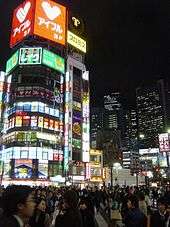
Since the 1973 oil crisis, energy Zeesun conservation has been an issue in Japan. All oil-based fuel is imported, so domestic sustainable energy is being developed.
The Energy Conservation Center[41] promotes energy efficiency in every aspect of Japan. Public entities are implementing the efficient use of energy for industries and research. It includes projects such as the Top Runner Program.[42] In this project, new appliances are regularly tested on efficiency, and the most efficient ones are made the standard.
Lebanon
In Lebanon and since 2002 The Lebanese Center for Energy Conservation (LCEC) has been promoting the development of efficient and rational uses of energy and the use of renewable energy at the consumer level. It was created as a project financed by the International Environment Facility (GEF) and the Ministry of Energy Water (MEW) under the management of the United Nations Development Programme (UNDP) and gradually established itself as an independent technical national center although it continues to be supported by the United Nations Development Programme (UNDP) as indicated in the Memorandum of Understanding (MoU) signed between MEW and UNDP on 18 June 2007.
Nepal
Until recently, Nepal has been focusing on the exploitation of its huge water resources to produce hydro power. Demand side management and energy conservation was not in the focus of government action. In 2009, bilateral Development Cooperation between Nepal and the Federal Republic of Germany, has agreed upon the joint implementation of "Nepal Energy Efficiency Programme". The lead executing agencies for the implementation are the Water and Energy Commission Secretariat (WECS). The aim of the programme is the promotion of energy efficiency in policy making, in rural and urban households as well as in the industry.[43] Due to the lack of a government organization that promotes energy efficiency in the country, the Federation of Nepalese Chambers of Commerce and Industry (FNCCI) has established the Energy Efficiency Centre under his roof to promote energy conservation in the private sector. The Energy Efficiency Centre is a non-profit initiative that is offering energy auditing services to the industries. The Centre is also supported by Nepal Energy Efficiency Programme of Deutsche Gesellschaft für Internationale Zusammenarbeit.[44] A study conducted in 2012 found out that Nepalese industries could save 160,000 megawatt hours of electricity and 8,000 terajoule of thermal energy (like diesel, furnace oil and coal) every year. These savings are equivalent to annual energy cost cut of up to 6.4 Billion Nepalese Rupees.[45][46] As a result of Nepal Economic Forum 2014,[47] an economic reform agenda in the priority sectors was declared focusing on energy conservation among others. In the energy reform agenda the government of Nepal gave the commitment to introduce incentive packages in the budget of the fiscal year 2015/16 for industries that practices energy efficiency or use efficient technologies (incl. cogeneration).[48]
New Zealand
In New Zealand the Energy Efficiency and Conservation Authority is the Government Agency responsible for promoting energy efficiency and conservation. The Energy Management Association of New Zealand is a membership based organization representing the New Zealand energy services sector, providing training and accreditation services with the aim of ensuring energy management services are credible and dependable.[49]
Nigeria
In Nigeria, the Lagos State Government is encouraging Lagosians to imbibe an energy conservation culture. In 2013, the Lagos State Electricity Board (LSEB)[50] ran an initiative tagged "Conserve Energy, Save Money" under the Ministry of Energy and Mineral Resources. The initiative is designed to sensitize Lagosians around the theme of energy conservation by influencing their behavior through do-it-yourself tips.[51] In September 2013, Governor Babatunde Raji Fashola of Lagos State and the campaign ambassador, rapper Jude 'MI' Abaga[52] participated in the Governor's conference video call[53] on the topic of energy conservation.
In addition to this, during the month of October (the official energy conservation month in the state), LSEB hosted experience centers in malls around Lagos State where members of the public were encouraged to calculate their household energy consumption and discover ways to save money using a consumer-focused energy app.[54] To get Lagosians started on energy conservation, solar lamps and energy-saving bulbs were also handed out.
In Kaduna State, the Kaduna Power Supply Company (KAPSCO) ran a program to replace all light bulbs in Public Offices; fitting energy-saving bulbs in place of incandescent bulbs. KAPSCO is also embarking on an initiative to retrofit all conventional streetlights in the Kaduna Metropolis to LEDs which consume much less energy.
Sri Lanka
Sri Lanka currently consumes fossil fuels, hydro power, wind power, solar power and dendro power for their day to day power generation. The Sri Lanka Sustainable Energy Authority is playing a major role regarding energy management and energy conservation. Today, most of the industries are requested to reduce their energy consumption by using renewable energy sources and optimizing their energy usage.
Turkey
Turkey aims to decrease by at least 20% the amount of energy consumed per GDP of Turkey by the year 2023 (energy intensity).[55]
United States
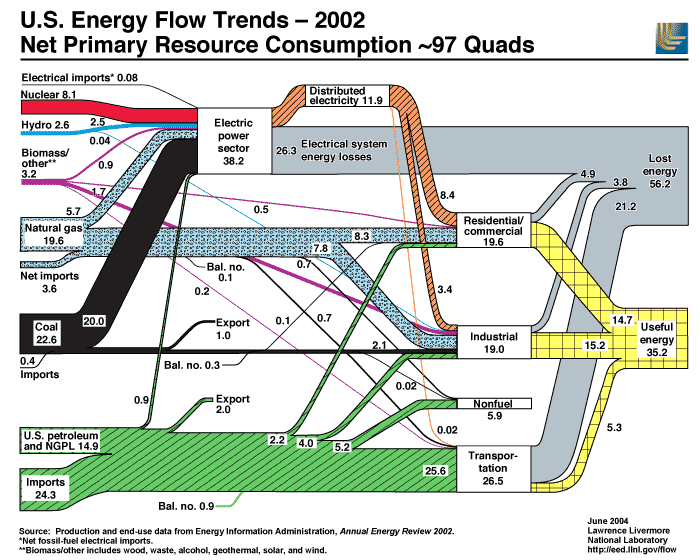
Energy usage in transportation and residential sectors, about half of U.S. energy consumption, is largely controlled by individual consumers. Commercial and industrial energy expenditures are determined by businesses entities and other facility managers. National energy policy has a significant effect on energy usage across all four sectors.
Another aspect of energy conversation is using Leadership in Energy and Environmental Design. (LEED) This program is not mandatory, it is voluntary. This program has many categories, Energy and Atmosphere Prerequisite, applies to energy conservation. This section focuses on energy performance, renewable energy, energy performance, and many more. This program is designed to promote energy efficiency and be a green building, which is part of conservation. As mention above “energy conservation are efforts made to reduce the consumption of energy.”
U.S. Green Building Council (2013). LEED Reference Guide for Building Design and Construction (v4 ed.). U.S. Green Building Council. pp. 318–466. ISBN 978-1932444186.
See also
- Annual fuel use efficiency
- Domestic energy consumption
- Efficient energy use
- Energy conservation law
- Energy crisis
- Energy monitoring and targeting
- Energy recovery
- EU Energy Efficiency Directive 2012/27/EU
- Green computing
- Heat pump
- High-temperature insulation wool
- Jevons paradox
- Khazzoom–Brookes postulate
- List of energy storage projects
- List of low-energy building techniques
- Low Carbon Communities
- Marine fuel management
- Minimum energy performance standard
- One Watt Initiative
- Overconsumption
- Passive house
- Renewable heat
- Smart grid
- Superinsulation
- Thermal efficiency
- Universal Metering Interface (UMI)
- Window film
- Zero-energy building
References
- Zehner, Ozzie (2018). Unintended consequences of green technologies – Uncorrected proof (PDF). Retrieved 14 June 2016.
- "A guide for effective energy saving". Renewable Energy World. Retrieved 14 June 2016.
- "Top 5 reasons to be energy efficient". Alliance to Save Energy (ASE). 20 July 2012. Archived from the original on 8 June 2016. Retrieved 14 June 2016.
- R.Chattopadhyay (2014). Green Tribology, Green Surface Engineering and Global Warming. ASM International,USA. ISBN 1627080643.
- Zehner, Ozzie (2012). Green Illusions. Lincoln and London: University of Nebraska Press. pp. 179–182.
- Pacific Gas and Electric Company, Southern California Edison (2011). "Guest Room Occupancy Controls—2013 California Building Energy Efficiency Standards" (PDF). California Energy Commission. Retrieved 10 May 2016.CS1 maint: uses authors parameter (link)
- Patrick Leslie, Joshua Pearce, Rob Harrap, Sylvie Daniel, "The application of smartphone technology to economic and environmental analysis of building energy conservation strategies", International Journal of Sustainable Energy 31(5), pp. 295–311 (2012). open access
- July 2009 European Commission's Directorate-General for Energy and Transport initiative, "Energy Savings from Intelligent Metering and Behavioural Change (INTELLIGENT METERING) http://www.managenergy.net/products/R1951.htm Archived 13 August 2010 at the Wayback Machine", 2009
- "Efficiency Valuation Organization".
- "LED Lighting – Department of Energy".
- "Certified Professionals | Building Performance Institute, Inc". www.bpi.org.
- "Home Energy Rating System Program (HERS)". Energy.ca.gov. Retrieved 29 March 2012.
- "Home Energy Rating System". Southface.org. Retrieved 29 March 2012.
- Stephens, B. , Carter, E. , Gall, E. , Earnest, C. , Walsh, E. , et al. (2011). Home energy-efficiency retrofits. Environmental Health Perspectives, 119(7), A283-a284.
- "Do-It-Yourself Home Energy Audits". Energy.gov.
- Patrick Leslie, Joshua Pearce, Rob Harrap, Sylvie Daniel, “The application of smartphone technology to economic and environmental analysis of building energy conservation strategies”, International Journal of Sustainable Energy 31(5), pp. 295-311 (2012). open access
- "Archived copy". Archived from the original on 24 September 2015. Retrieved 21 October 2014.CS1 maint: archived copy as title (link)
- Wayner, Peter (8 May 2009). "An Energy Dashboard for Buildings".
- "DC Green Schools Challenge : High School Makeup Tips". DC Green Schools Challenge.
- "BACnet". Drupal.org. 9 April 2014.
- "ENERGY EFFICIENCY: When will consumers realize the 60-cent light bulb wasn't a bargain?".
- "A Boom in Utility Rebates Drives LED Lighting". 18 September 2012.
- Commission, California Energy. "Consumer Energy Center – Incandescent, LED, Fluorescent, Compact Fluorescent and Halogen Bulbs". Archived from the original on 28 July 2012.
- "Energy efficiency: The elusive negawatt". The Economist. The Economist. 8 May 2008. Retrieved 21 August 2013.
- Breukers, Heiskanen, et al. (2009). Interaction schemes for successful demand-side management. Deliverable 5 of the CHANGING BEHAVIOUR project. Funded by the EC (#213217)
- "Toolkit for managers of energy conservation projects: How to learn about people's topical concerns". Archived from the original on 20 August 2011.
- Scott Davis; Dana K. Mirick; Richard G. Stevens (2001). "Night Shift Work, Light at Night, and Risk of Breast Cancer". Journal of the National Cancer Institute. 93 (20): 1557–1562. doi:10.1093/jnci/93.20.1557. PMID 11604479. Archived from the original on 12 August 2003. Retrieved 4 March 2006.
- Bain, A (1997). "The Hindenburg Disaster: A Compelling Theory of Probable Cause and Effect". Procs. NatL Hydr. Assn. 8th Ann. Hydrogen Meeting, Alexandria, Va., March 11–13: 125–128.
- Lumina Technologies Inc., Santa Rosa, Ca., Survey of 156 California commercial buildings energy use, August 1996
- "Central heating controls | Centre for Sustainable Energy". www.cse.org.uk.
- "Global Energy Efficiency".
- "State Energy Savings Performance Contracting". www.ncsl.org.
- http://www.portal.state.pa.us/portal/server.pt/community/guaranteed_energy_savings_act/14339
- "2013 Pacific Energy Summit Working Papers". Nbr.org. 22 April 2013. Archived from the original on 1 April 2017. Retrieved 21 August 2013.
- "Pacific Energy Summit". Archived from the original on 1 April 2017. Retrieved 13 May 2013.
- "Energy: What do we want to achieve ? – European commission". Ec.europa.eu. Retrieved 29 July 2010.
- "Directive 2012/27/EU of the European Parliament and of the Council of 25 October 2012 on energy efficiency, amending Directives 2009/125/EC and 2010/30/EU and repealing Directives 2004/8/EC and 2006/32/EC". Official journal of the European Union. L 315: 1–56. 14 November 2012. Retrieved 3 August 2016.
- For an Energy-Efficient Millennium: SAVE 2000 Archived 17 August 2014 at the Wayback Machine, Directorate-General for Energy
- "EUROPA - Official website of the European Union - A-Z index". Archived from the original on 16 July 2012. Retrieved 7 August 2019.
- Fraunhofer Institute for Systems and Innovation Research ISI (2019) Study on Energy Savings Scenarios 2050. See https://www.isi.fraunhofer.de/content/dam/isi/dokumente/ccx/2019/Report_Energy-Savings-Scenarios-2050.pdf with a summary in https://www.isi.fraunhofer.de/content/dam/isi/dokumente/ccx/2019/Summary_Energy-Savings-Scenarios-2050.pdf
- "Home". ECCJ / Asia Energy Efficiency and Conservation Collaboration Center.
- "ウォーターサーバーの導入前にコスパを比較 | ウォーターサーバー選びを妥協したくない" (PDF). Archived from the original on 24 July 2015.
- "Nepal Energy Efficiency Programme". Water and Energy Commission Secretariat (WECS). 2011. Archived from the original on 6 January 2014. Retrieved 6 December 2013.
- "Introduction". Energy Efficiency Centre. 2013. Retrieved 30 December 2013.
- "Baseline Study of Selected Sector Industries to assess The Potentials for more Efficient use of Energy in Nepal" (PDF). Deutsche Gesellschaft für Internationale Zusammenarbeit (GIZ). 2016. Archived from the original (PDF) on 6 January 2014. Retrieved 2 January 2014.
- "Baseline Study of Selected Sector Industries to assess The Potentials for more Efficient use of Energy in Nepal". Deutsche Gesellschaft für Internationale Zusammenarbeit (GIZ). 2012. Retrieved 2 January 2014.
- "Agri, tourism, energy in focus at Nepal Economic Summit". Kantipur Newspaper. 2014. Retrieved 7 April 2014.
- "NEPAL ECONOMIC SUMMIT 2014 DECLARATION – A COMMITMENT TO ECONOMIC REFORM". FNCCI. 2014. Retrieved 7 April 2014.
- "Gratis Energienota Scan | Jaararfrekening Energie". switchCollectief.NL (in Dutch). Retrieved 7 November 2016.
- Lagos State Electricity Board (LSEB) Archived 13 November 2013 at the Wayback Machine
- do-it-yourself tips Archived 13 November 2013 at the Wayback Machine
- "MI becomes Lagos Energy Ambassador – Vanguard News". 4 September 2013.
- Governor's first ever Google's Hangout on YouTube
- "Archived copy". Archived from the original on 22 November 2014. Retrieved 25 November 2014.CS1 maint: archived copy as title (link)
- "ENER GY EFFICIENCY STRATEGY PAPER" (PDF). Turkish government.
- US Dept. of Energy, "Annual Energy Report" (July 2006), Energy Flow diagram
Further reading
- GA Mansoori, N Enayati, LB Agyarko (2016), Energy: Sources, Utilization, Legislation, Sustainability, Illinois as Model State, World Sci. Pub. Co., ISBN 978-981-4704-00-7
- Alexeew, Johannes; Carolin Anders and Hina Zia (2015): Energy-efficient buildings – a business case for India? An analysis of incremental costs for four building projects of the Energy-Efficient Homes Programme. Berlin/New Delhi: adelphi/TERI
- Gary Steffy, Architectural Lighting Design, John Wiley and Sons (2001) ISBN 0-471-38638-3
- Lumina Technologies, Analysis of energy consumption in a San Francisco Bay Area research office complex, for (confidential) owner, Santa Rosa, Ca. 17 May 1996
- Robb, Drew (2 June 2007). "GSA paves way for IT-based buildings – Government Computer News". Gcn.com. Archived from the original on 25 December 2008. Retrieved 29 July 2010.
External links
| Wikibooks has a book on the topic of: How to reduce home energy usage |
- bigEE – Your guide to energy efficiency in buildings
- Energy saving advice and grants for UK consumers
- Energy efficiency and renewable energy at the U.S. Department of Energy
- EnergyStar – for commercial buildings and plants
- Ulrich Hottelet: Want to Save the Earth? Pick a Clothesline, Atlantic Times, November 2007
- Energy Efficiency in Asia and the Pacific Asian Development Bank
- Energy Saving Tips Save up to $100 on power bills per year by switching off any unused appliances.
